“Las Meninas” by Diego Velázquez – The Spanish Painter’s Artwork
The Las Meninas painting by Diego Velázquez is arguably one of the most iconic works in art history. The Spanish painter’s masterpiece has captivated audiences for centuries with its intricate composition, masterful use of light and shadow, and enigmatic subject matter. Las Meninas is a work of art that has been analyzed, debated, and admired by art critics and scholars alike. In this article, we will delve into the background and significance of this painting, explore Meninas’s meaning, and provide a comprehensive Las Meninas analysis to better understand why this work of art continues to hold such a powerful place in the canon of art history.
Artist Abstract: Who Was Diego Velázquez?
Diego Velázquez was a Spanish painter born in Seville, Spain in 1599, the son of a Portuguese nobleman and a Spanish mother. He began his artistic training under Francisco Herrera the Elder (1576 – 1656), a painter is known for his dramatic and expressive style. In 1617, Velázquez entered the workshop of Francisco Pacheco (1564 – 1644), a prominent artist and art theorist in Seville, where he learned the techniques of oil painting and portraiture. In his early years, Velázquez created several religious paintings and mythological scenes, including Apollo in the Forge of Vulcan (1630) and The Adoration of the Magi (1619). However, it was his portraiture that would become his greatest legacy. His first major commission came from the Count-Duke of Olivares (1587 – 1645), who appointed Velázquez as court painter to King Philip IV of Spain in 1623.
Over the next few decades, Velázquez created some of his most famous paintings, including Las Meninas (1656), which depicts the princess and her entourage in the court of King Philip IV.
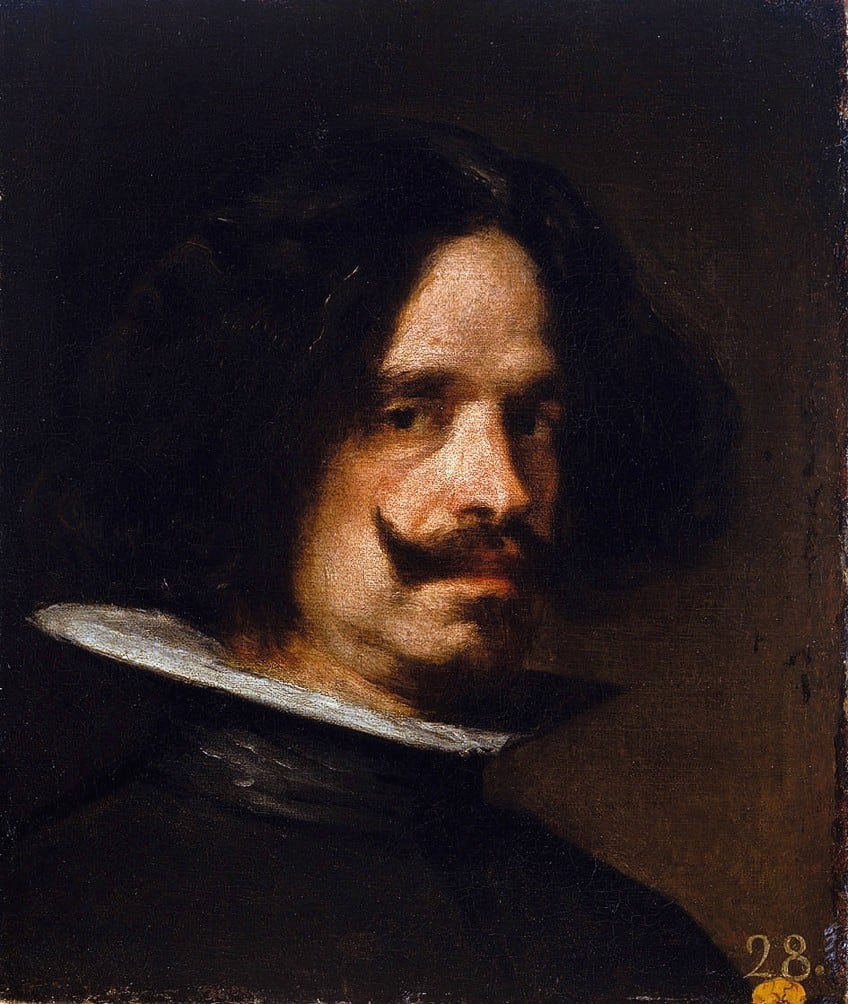
He also painted numerous portraits of the royal family and other courtiers, including The Surrender of Breda (1634 – 1635) and Portrait of Innocent X (1650). Velázquez’s style was characterized by his mastery of light and shadow, his use of loose brushwork to create a sense of movement and spontaneity, and his ability to capture the inner psychology of his subjects.
His influence on art history cannot be overstated; his innovative techniques and realistic approach to portraiture had a profound impact on later artists, including the Impressionists.
In addition to his artistry, Velázquez was also known for his diplomatic skills. He was sent on several diplomatic missions to Italy to acquire art for the royal collection, and he used these opportunities to meet with other artists and scholars and to study the works of the Italian masters. Despite his success and accolades, Velázquez remained humble and dedicated to his craft. He continued to paint until his death in 1660, leaving behind a body of work that continues to inspire and captivate art lovers around the world.
The Las Meninas Painting in Context
| Date | 1656 |
| Medium | Oil on canvas |
| Dimensions (cm) | 318 x 276 |
| Genre | Portrait and history painting |
| Style | Baroque |
| Subject | Margaret Theresa of Spain, Mariana of Austria, Maria Bárbolaand, and Philip IV of Spain |
| Location | Museo Nacional del Prado, Madrid, Spain |
Before we go on to doing a thorough Las Meninas analysis, it is important to first understand the socio-political context within which this Spanish painter, Diego Velázquez, created the Las Meninas painting. As well as, to look at what was happening in the artist’s personal life and career when he painted the artwork.
Las Meninas Painting in the Spanish Socio-Political Context
Diego Velázquez’s Las Meninas depicts a scene in the Spanish court during the reign of King Philip IV, featuring the king and queen, their daughter Margaret Theresa, and a group of ladies-in-waiting, servants, and courtiers. While the painting is celebrated for its masterful composition, use of light and shadow, and depiction of everyday life in the royal court, it also reflects the socio-political climate of 17th-century Spain.
A Tough Time in Spain
At the time “Las Meninas” was created in 1656, Spain was a world power in decline. The country had suffered significant losses in the Thirty Years War and the Franco-Spanish War, and its economy was struggling. In addition, there were deep divisions within Spanish society, particularly between the nobility and the lower classes.
The court of King Philip IV was known for its extravagance and opulence, but also for its political instability and corruption.
The Complexity and Contradictions of the Spanish Court
Against this backdrop, Velázquez’s painting stands out as a masterpiece that captures the complexity and contradictions of the Spanish court. The painting is both a celebration of the royal family and a critique of the power structures that surround them. Velázquez portrays the king and queen as distant and aloof figures, standing at the center of the composition but separated from the other figures by a spatial and psychological distance. The figure of Margaret Theresa, who was betrothed to the Holy Roman Emperor, is portrayed as a fragile and vulnerable child, surrounded by a group of attentive ladies-in-waiting.
What is most striking about Las Meninas is the way Velázquez places himself in the painting, both literally and metaphorically.

The artist appears in the background, standing before a large canvas and holding a brush and palette. He is dressed in the same clothes as the king and queen, suggesting that he is an equal member of the court. This self-portrait is a bold assertion of artistic and social identity, and it challenges the traditional hierarchies of the Spanish court. Velázquez’s self-portrait also raises questions about the essence of art and representation. By including himself in the painting, Velázquez blurs the boundaries between reality and illusion, between the viewer and the viewed.
He suggests that art is not simply a mirror of reality, but an active participant in the construction of meaning and identity. This is particularly relevant in a period when Spain was struggling to define itself in the wake of its decline as a world power.
Las Meninas Painting in the Context of Diego Velázquez’s Career and Personal Life
At the time Velázquez painted Las Meninas, he was living and working in Madrid, where he had been appointed court painter to King Philip IV in 1623. Velázquez was known for his skill in capturing the likeness and personality of his subjects, as well as his mastery of composition and the use of light and shadow.
His work was greatly admired by his contemporaries, and he was held in high esteem by the Spanish royal family.
Velázquez’s Personal Life
In addition to his work as a court painter, Velázquez also had a personal life that was marked by both professional and personal relationships. He was married to Juana Pacheco (1602 – 1660), who was the daughter of his teacher and mentor, Francisco Pacheco. Juana was a respected artist in her own right, and she worked closely with her husband on many of his projects.
Together, they had two daughters, Francisca and Ignacia, who also became artists.

Velázquez’s Style
In terms of his artistic development, Velázquez was known for his ability to blend different styles and techniques to create his own unique visual language. He drew inspiration from a wide range of sources, including the work of Italian Renaissance masters such as Titian (Unknown date – 1576) and Caravaggio (1571 – 1610), as well as from the Dutch and Flemish painters who were then popular in Spain.
He was also influenced by the new artistic theories and techniques that were being developed in France.
Despite his many artistic influences, Velázquez’s work was marked by a distinctive style that was characterized by a focus on the individual, psychological depth, and the use of light and shadow to create a sense of drama and movement. These qualities are evident in Las Meninas, where the artist skillfully captures the personalities and relationships of the figures in the painting, and uses light and shadow to create a sense of depth and spatial complexity.
Art History Context: What Is the Baroque Art Movement?
The Baroque art movement emerged in Europe in the 17th century, and it is characterized by a highly ornate style that emphasizes grandeur, drama, and theatricality. Baroque art is known for its use of intense light and shadow, rich color palettes, and complex compositions that create a sense of movement and dynamism. It is also marked by a fascination with religious and mythological themes, and a desire to create a sense of awe and wonder in the viewer.
Diego Velázquez is considered a Baroque artist because his work embodies many of the key characteristics of the movement. He was a Master of Composition, and his paintings are known for their dynamic sense of movement and spatial complexity.
He also made use of light and shadow to create dramatic effects, and his color palettes were often rich and vibrant. Like other Baroque artists, Velázquez was also interested in religious and mythological themes, and he frequently depicted the royal court and other aristocratic subjects in his paintings.

One of Velázquez’s most famous works, the Las Meninas painting, is a perfect example of Baroque art. The painting features an elaborate composition that includes numerous people arranged in a complex spatial relationship. The use of light and shadow in the painting creates a sense of depth and movement, and the overall effect is one of grandeur and drama. Another example of Velázquez’s Baroque style can be seen in his Portrait of Innocent X (1650).
This painting features a highly detailed and ornate composition, with the pope’s elaborate clothing and surroundings adding to the overall sense of grandeur. The use of light and shadow in the painting creates a dramatic effect that emphasizes the pope’s power and importance.
Velázquez’s interest in religious themes is evident in his painting The Crucifixion (1632). This work features a highly emotional and dramatic composition that captures the intense suffering of Christ on the cross. The use of light and shadow in the painting creates a sense of depth and movement, and the overall effect is one of awe and wonder. In addition to these works, Velázquez also created a wide range of other paintings that demonstrate his mastery of the Baroque style. His portraits of the Spanish royal family, for example, are notable for their use of color, composition, and dramatic lighting to create a sense of grandeur and majesty.
Las Meninas Analysis
In the Las Meninas analysis section of this article, we will discuss the visual and technical qualities of this painting. Diego Velázquez’s compositional, textural, color, perspective, and other specialized choices are what makes this artwork so special and can give us insight into this Spanish artist’s influence on the development of art.
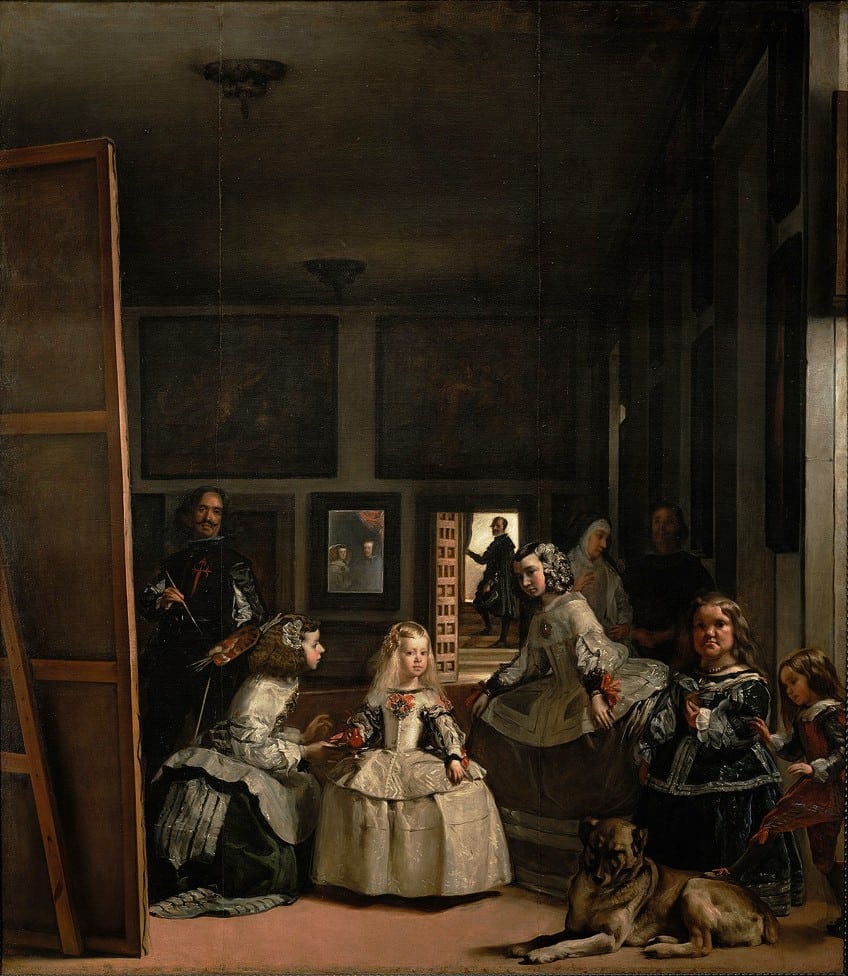
Composition
Compositionally, Las Meninas is a masterful work of art. Velázquez creates a sense of depth and movement in the painting by carefully arranging the figures in a considered relationship. Las Meninas was painted in Diego Velázquez’s studio in Madrid at the Royal Alcázar. The 18th-century art chronicler, Antonio Palomino, wrote in his book An Account of the Lives and Works of the Most Eminent Spanish Painters, Sculptors and Architects, and where Their Several Performances are to be Seen (1739), a lot about the people and physical space depicted in the painting.
The painting depicts Princess Doña Margarita Maria of Austria (1651 – 1673) at the center of the chamber, surrounded by her ladies-in-waiting (or meninas). At the back of the room, there is a door where Don Jose de Nieto Velazquez, the marshal of the queen’s castle, stands.

There is also a mirror that reflects the backlit figures of King Philip (1527 – 1598) and Queen Mariana (1634 – 1696), indicating that they were present during the portrait painting. Velázquez himself is seen in the painting standing behind his large canvas, painting the scene. The painting has sparked several theories about the presence of action beyond the frame and the events leading up to the scene depicted.
Despite the uncertainties, the gestures and gazes of the various figures suggest that there is more to the painting than what meets the eye.
Subject Matter
The subject matter of Las Meninas is both historical and allegorical. On one level, the painting is a portrait of the Spanish royal court, depicting the young Infanta Margarita and her ladies-in-waiting in their ornate clothing and surroundings. However, the painting is also full of allegorical meaning, with Velázquez using the figures in the painting to explore themes of power, status, and artistic creation.
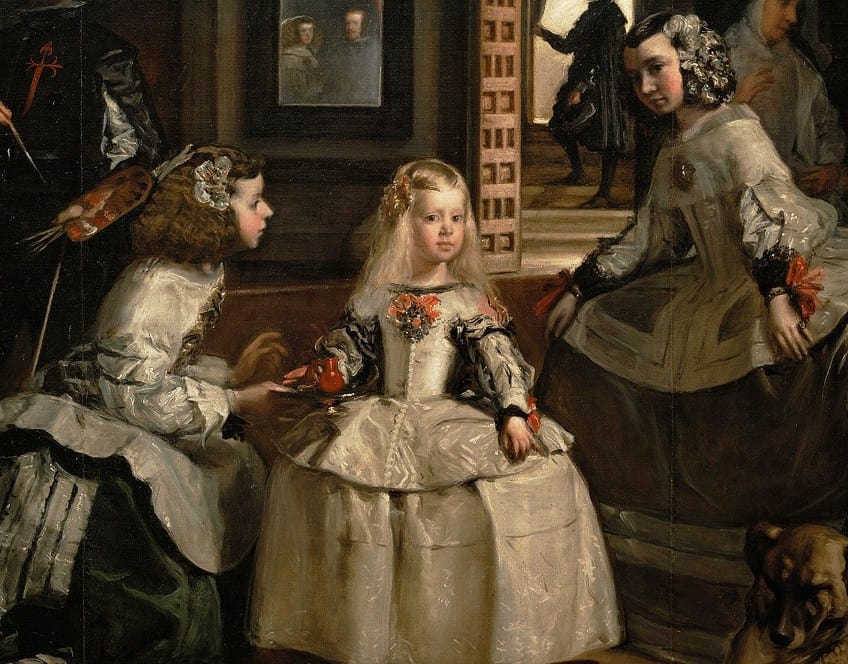
Color and Light
Color and light play a crucial role in the painting, with Velázquez using a rich and vibrant palette to create a sense of drama and intensity. The use of light and shadow in the painting is also masterful, with Velázquez carefully manipulating the light to create a sense of depth and dimensionality. The light source in the painting appears to be coming from the left, casting long shadows across the floor and highlighting the figures in the painting.
The overall effect is one of grandeur and majesty, with the rich colors and dramatic lighting creating a sense of awe and wonder in the viewer.

Texture
Texture is another important element of the painting, with Velázquez using a range of techniques to create a sense of depth and dimensionality. The clothing worn by the figures in the painting is highly detailed and ornate, with the intricate patterns and textures adding to the overall sense of grandeur and opulence. The use of texture also creates a sense of tactility, with the viewer able to almost feel the luxurious fabrics and ornate jewelry depicted in the painting.

Perspective
Perspective and form are also crucial elements of Las Meninas, with Velázquez using these techniques to create a sense of movement and dynamism in the painting. The use of perspective is particularly effective, with Velázquez using the lines of the floor tiles and the edges of the canvas to create a sense of depth and dimensionality.
The form of the figures in the painting is also highly detailed, with Velázquez carefully capturing the shapes and contours of their bodies and clothing to create a sense of physical presence.
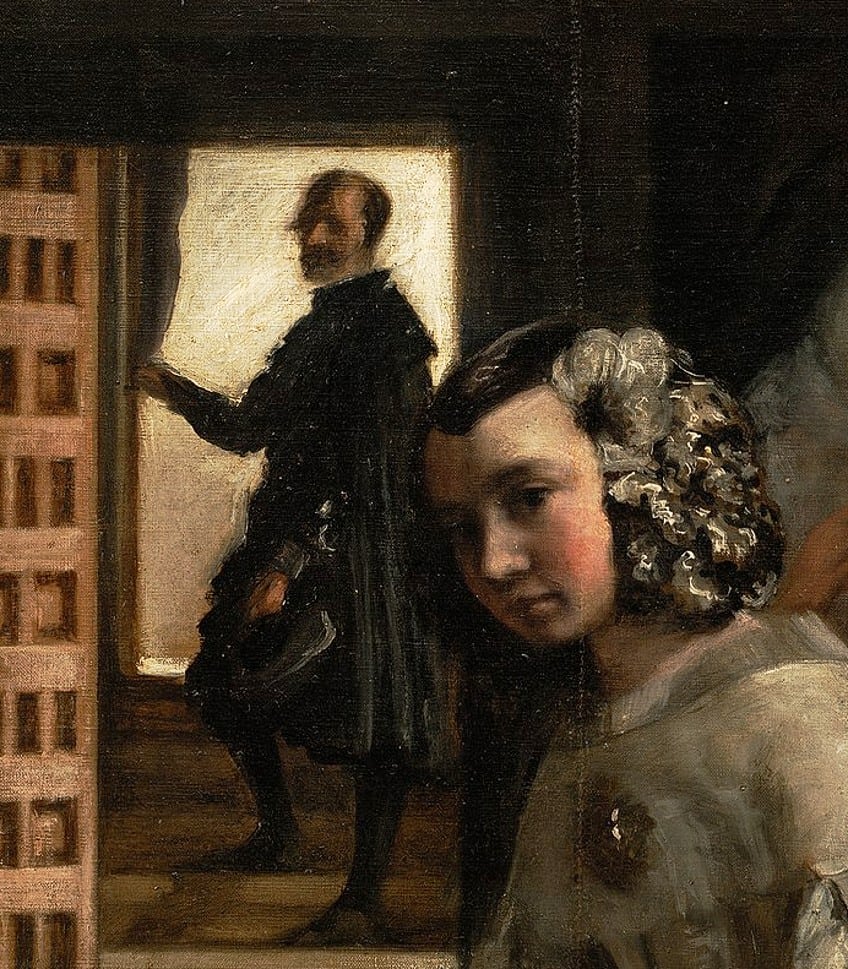
Meninas Meaning
The meaning of Las Meninas has been the subject of much scholarly debate and interpretation over the years. One of the most intriguing aspects of the painting is the presence of Velázquez himself, who is depicted standing in front of a canvas, holding a brush and palette. By including himself in the painting, Velázquez is drawing attention to the process of artistic creation, and the role of the artist in society.
His presence also suggests that he was highly respected by the Spanish royal court, and was considered to be a master of his craft.
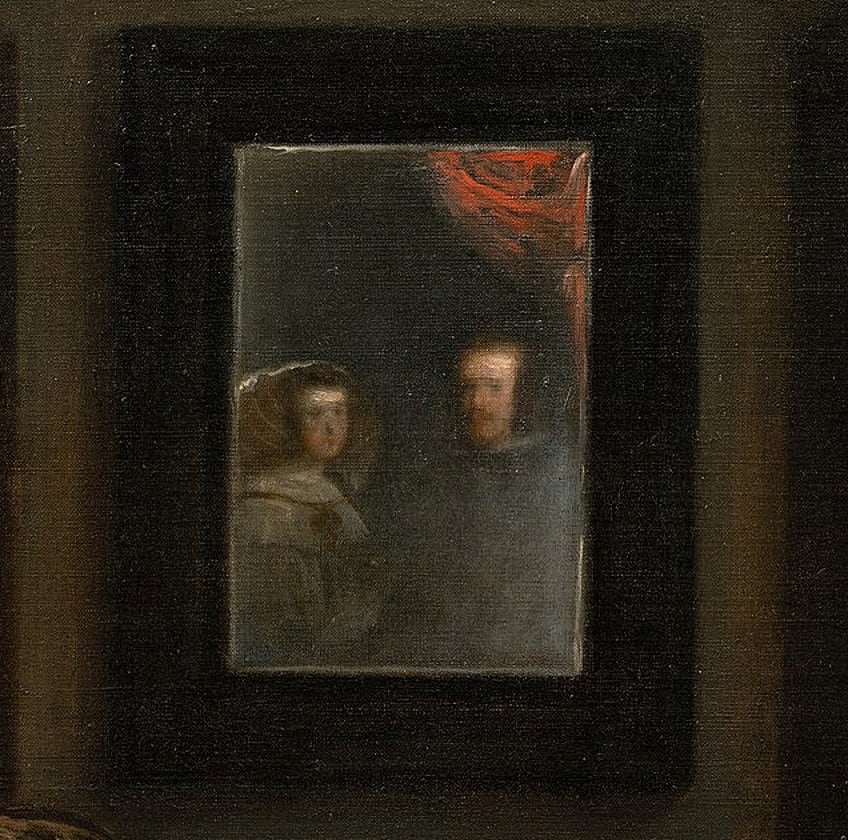
The central figure of Infanta Margarita also carries significant symbolic weight. As the daughter of King Philip IV of Spain, she represents the future of the Spanish monarchy, and her presence in the painting emphasizes the importance of lineage and succession in the royal court. The ladies-in-waiting surrounding her also carry symbolic weight, with their ornate clothing and jewels representing the wealth and opulence of the Spanish court.
The group of courtiers in the background of the painting also carries symbolic significance. They are depicted gathered around a doorway, suggesting that they are waiting for someone important to arrive.
Some scholars have suggested that the figure they are waiting for is the King himself, who is perhaps about to enter the room. If this is the case, it would emphasize the importance of the Spanish monarchy and the role of the royal court in Spanish society. Overall, Las Meninas is a complex and highly symbolic work of art that explores a range of themes and ideas.
The First Exhibition of Las Meninas by Diego Velázquez
Las Meninas was first exhibited in the royal palace of Madrid in 1656. The painting was commissioned by King Philip IV of Spain, and it is believed that he kept it in his private apartments. It wasn’t until after Velázquez’s death that the painting was displayed in public for the first time. The initial reception of Las Meninas by the public was mixed. Some viewers were struck by the painting’s remarkable realism and attention to detail, while others found it confusing and difficult to interpret. However, despite the mixed reactions, the painting soon gained a reputation as one of the most important works of art in Spanish history.
One of the most notable art critics of the time, Francisco de Goya (1746 – 1828), was particularly impressed by Las Meninas. In his writings, he praised Velázquez’s ability to capture the essence of the Spanish court and hailed the painting as a masterpiece of Baroque art.
Goya’s enthusiasm for the painting helped to cement its status as an important work of art and contributed to its enduring popularity. However, not all art critics were as enthusiastic about Las Meninas. In his writings, the French art critic Louis Étienne Watelet (1718 – 1786) criticized the painting for its lack of clarity and focus, noting that it was difficult to understand what Velázquez was trying to convey. He also criticized the painting’s realism, noting that it lacked the idealization and beauty that he believed was essential to great art.
In conclusion, Las Meninas by Diego Velázquez is a masterpiece of Baroque art and a testament to the skill and creativity of this Spanish painter. Through its intricate composition, realistic portrayal of the Spanish court, and the use of light and shadow, the painting captures a moment in time and invites viewers to explore the world of the royal palace. While its meaning may remain somewhat elusive, the painting continues to fascinate art enthusiasts and critics alike, and its enduring popularity is a testament to its enduring relevance and artistic power. As a work of art, Las Meninas represents a pinnacle of the Baroque period, and its influence can be felt in countless works of art that have followed in the centuries since its creation. It is a testament to the enduring power and beauty of great art, and a reminder of the importance of creativity, skill, and imagination in our lives.
Frequently Asked Questions
What Is Las Meninas’s Meaning?
Las Meninas is a painting by the Spanish artist Diego Velázquez, created in 1656. The title Las Meninas can be translated from Spanish as The Maids of Honour or The Ladies-in-Waiting. The painting depicts a scene from the court of King Philip IV of Spain, and it shows the artist himself painting a portrait of the king’s daughter, Princess Margaret Theresa. The painting is considered one of the masterpieces of Western art, and is celebrated for its use of light and shadow, composition, and representation of the relationship between the artist, the viewer, and the subject.
What Is the Socio-Political Significance of Las Meninas by Diego Velázquez?
Las Meninas is a masterpiece of Spanish art that reflects the socio-political climate of 17th-century Spain. Velázquez’s painting captures the complexity and contradictions of the Spanish court, and challenges traditional hierarchies by placing himself in the composition as an equal member of the court. The painting raises questions about the nature of art and representation, and suggests that art has the power to shape our understanding of ourselves and the world around us.
What Is the Professional Significance of Las Meninas to Diego Velázquez’s Career?
Las Meninas is a masterpiece of Baroque art that reflects the unique talents and influences of Diego Velázquez. The painting showcases the artist’s skill in capturing the individuality and psychology of his subjects, as well as his mastery of composition and the use of light and shadow. Velázquez’s personal life and relationships, as well as his artistic development and other works, all contributed to the creation of this iconic masterpiece. Las Meninas remains a testament to the enduring legacy of one of the greatest painters in the history of Western art.
What Is the Baroque Art Movement?
The Baroque art movement emerged in Europe in the 17th century and is characterized by a highly ornate style that emphasizes grandeur, drama, and theatricality. Baroque art is known for its use of intense light and shadow, rich color palettes, and complex compositions that create a sense of movement and dynamism. It is marked by a fascination with religious and mythological themes and a desire to create a sense of awe and wonder in the viewer. Baroque artists sought to capture a sense of grandeur and majesty in their works, often featuring highly ornate and detailed compositions that conveyed a powerful emotional impact.
Why Is Diego Velázquez Considered a Baroque Artist?
Diego Velázquez is considered a Baroque artist because his work embodies many of the key characteristics of the movement. His paintings are marked by a highly ornate style, a fascination with religious and mythological themes, and a desire to create a sense of awe and wonder in the viewer. Velázquez’s skill in composition, use of light and shadow, and rich color palettes are all hallmarks of Baroque art, and his legacy as one of the greatest artists of the movement is well-deserved.
Jordan Anthony is a Cape Town-based film photographer, curator, and arts writer. She holds a Bachelor of Art in Fine Arts from the University of the Witwatersrand, Johannesburg, where she explored themes like healing, identity, dreams, and intuitive creation in her Contemporary art practice. Jordan has collaborated with various local art institutions, including the KZNSA Gallery in Durban, the Turbine Art Fair, and the Wits Art Museum. Her photography focuses on abstract color manipulations, portraiture, candid shots, and urban landscapes. She’s intrigued by philosophy, memory, and esotericism, drawing inspiration from Surrealism, Fluxus, and ancient civilizations, as well as childhood influences and found objects. Jordan is working for artfilemagazine since 2022 and writes blog posts about art history and photography.
Learn more about Jordan Anthony and about us.
Cite this Article
Jordan, Anthony, ““Las Meninas” by Diego Velázquez – The Spanish Painter’s Artwork.” artfilemagazine – Your Online Art Source. April 12, 2023. URL: https://artfilemagazine.com/las-meninas-by-diego-velazquez/
Anthony, J. (2023, 12 April). “Las Meninas” by Diego Velázquez – The Spanish Painter’s Artwork. artfilemagazine – Your Online Art Source. https://artfilemagazine.com/las-meninas-by-diego-velazquez/
Anthony, Jordan. ““Las Meninas” by Diego Velázquez – The Spanish Painter’s Artwork.” artfilemagazine – Your Online Art Source, April 12, 2023. https://artfilemagazine.com/las-meninas-by-diego-velazquez/.



